The Impact of Knowledge Spillovers on Economic Growth from a National Perspective: A Comprehensive Analysis
Abstract
1. Introduction
- How does the economic cycle affect the knowledge spillovers?
- How do knowledge spillovers affect economic growth?
- What are the prospects for economic growth based on the knowledge spillovers?
2. Theoretical Background
2.1. Knowledge Spillovers
2.2. Economic Growth
3. Methodology
4. Results of Systematic Literature Review
4.1. VOSviewer® Bibliometric Analysis
4.2. Effects of Economic Cycles on Knowledge Spillovers
4.3. Effects of the Spillover of Knowledge on the Economic Growth of a Nation
5. Case Studies: Knowledge Spillovers and Economic Cycles in Germany, France, and Spain
6. Discussion
7. Conclusions and Limitations
Author Contributions
Funding
Institutional Review Board Statement
Informed Consent Statement
Data Availability Statement
Conflicts of Interest
Appendix A
| Section and Topic | Item # | Checklist Item | Location Where Item Is Reported |
|---|---|---|---|
| TITLE | |||
| Title | 1 | Identify the report as a systematic review. | 1 |
| ABSTRACT | |||
| Abstract | 2 | See the PRISMA 2020 for Abstracts checklist. | 1 |
| INTRODUCTION | |||
| Rationale | 3 | Describe the rationale for the review in the context of existing knowledge. | 2 |
| Objectives | 4 | Provide an explicit statement of the objective(s) or question(s) the review addresses. | 2 |
| METHODS | |||
| Eligibility criteria | 5 | Specify the inclusion and exclusion criteria for the review and how studies were grouped for the syntheses. | 3 |
| Information sources | 6 | Specify all databases, registers, websites, organizations, reference lists and other sources searched or consulted to identify studies. Specify the date when each source was last searched or consulted. | 3 |
| Search strategy | 7 | Present the full search strategies for all databases, registers and websites, including any filters and limits used. | 3 |
| Selection process | 8 | Specify the methods used to decide whether a study met the inclusion criteria of the review, including how many reviewers screened each record and each report retrieved, whether they worked independently, and if applicable, details of automation tools used in the process. | 3 |
| Data collection process | 9 | Specify the methods used to collect data from reports, including how many reviewers collected data from each report, whether they worked independently, any processes for obtaining or confirming data from study investigators, and if applicable, details of the automation tools used in the process. | 3 |
| Data items | 10a | List and define all outcomes for which data were sought. Specify whether all results that were compatible with each outcome domain in each study were sought (e.g., for all measures, time points, analyses), and if not, the methods used to decide which results to collect. | 2 |
| 10b | List and define all other variables for which data were sought (e.g., participant and intervention characteristics, funding sources). Describe any assumptions made about any missing or unclear information. | 3 | |
| Study risk of bias assessment | 11 | Specify the methods used to assess risk of bias in the included studies, including details of the tool(s) used, how many reviewers assessed each study and whether they worked independently, and if applicable, details of automation tools used in the process. | - |
| Effect measures | 12 | Specify for each outcome the effect measure(s) (e.g., risk ratio, mean difference) used in the synthesis or presentation of results. | - |
| Synthesis methods | 13a | Describe the processes used to decide which studies were eligible for each synthesis (e.g., tabulating the study intervention characteristics and comparing against the planned groups for each synthesis (item #5)). | 3 |
| 13b | Describe any methods required to prepare the data for presentation or synthesis, such as handling of missing summary statistics, or data conversions. | 3 | |
| 13c | Describe any methods used to tabulate or visually display results of individual studies and syntheses. | 2 | |
| 13d | Describe any methods used to synthesize results and provide a rationale for the choice(s). If meta-analysis was performed, describe the model(s), method(s) to identify the presence and extent of statistical heterogeneity, and software package(s) used. | - | |
| 13e | Describe any methods used to explore possible causes of heterogeneity among study results (e.g., subgroup analysis, meta-regression). | - | |
| 13f | Describe any sensitivity analyses conducted to assess robustness of the synthesized results. | - | |
| Reporting bias assessment | 14 | Describe any methods used to assess risk of bias due to missing results in a synthesis (arising from reporting biases). | - |
| Certainty assessment | 15 | Describe any methods used to assess certainty (or confidence) in the body of evidence for an outcome. | 1 |
| RESULTS | |||
| Study selection | 16a | Describe the results of the search and selection process, from the number of records identified in the search to the number of studies included in the review, ideally using a flow diagram. | 3 |
| 16b | Cite studies that might appear to meet the inclusion criteria, but which were excluded, and explain why they were excluded. | 3 | |
| Study characteristics | 17 | Cite each included study and present its characteristics. | 3 |
| Risk of bias in studies | 18 | Present assessments of risk of bias for each included study. | - |
| Results of individual studies | 19 | For all outcomes, present, for each study: (a) summary statistics for each group (where appropriate) and (b) an effect estimate and its precision (e.g., confidence/credible interval), ideally using structured tables or plots. | - |
| Results of syntheses | 20a | For each synthesis, briefly summarize the characteristics and risk of bias among contributing studies. | - |
| 20b | Present results of all statistical syntheses conducted. If meta-analysis was conducted, present for each the summary estimate and its precision (e.g., confidence/credible interval) and measures of statistical heterogeneity. If comparing groups, describe the direction of the effect. | - | |
| 20c | Present results of all investigations of possible causes of heterogeneity among study results. | - | |
| 20d | Present results of all sensitivity analyses conducted to assess the robustness of the synthesized results. | - | |
| Reporting biases | 21 | Present assessments of risk of bias due to missing results (arising from reporting biases) for each synthesis assessed. | - |
| Certainty of evidence | 22 | Present assessments of certainty (or confidence) in the body of evidence for each outcome assessed. | - |
| DISCUSSION | |||
| Discussion | 23a | Provide a general interpretation of the results in the context of other evidence. | 13 |
| 23b | Discuss any limitations of the evidence included in the review. | 13 | |
| 23c | Discuss any limitations of the review processes used. | - | |
| 23d | Discuss implications of the results for practice, policy, and future research. | - | |
| OTHER INFORMATION | |||
| Registration and protocol | 24a | Provide registration information for the review, including register name and registration number, or state that the review was not registered. | 2 |
| 24b | Indicate where the review protocol can be accessed, or state that a protocol was not prepared. | 2 | |
| 24c | Describe and explain any amendments to information provided at registration or in the protocol. | 2,3 | |
| Support | 25 | Describe sources of financial or non-financial support for the review and the role of the funders or sponsors in the review. | 15 |
| Competing interests | 26 | Declare any competing interests of review authors. | 15 |
| Availability of data, code and other materials | 27 | Report which of the following are publicly available and where they can be found: template data collection forms; data extracted from included studies; data used for all analyses; analytic code; any other materials used in the review. | 2 |
References
- Lee, G. The Effectiveness of International Knowledge Spillover Channels. Eur. Econ. Rev. 2006, 50, 2075–2088. [Google Scholar] [CrossRef]
- de Wit-de Vries, E.; Dolfsma, W.A.; van der Windt, H.J.; Gerkema, M.P. Knowledge Transfer in University–Industry Research Partnerships: A Review. J. Technol. Transf. 2019, 44, 1236–1255. [Google Scholar] [CrossRef]
- Colino, A.; Benito-Osorio, D.; Armengot, C.R. How Much Does Innovation Matter for Economic Growth? Manag. Decis. 2014, 52, 313–325. [Google Scholar] [CrossRef]
- Preobrazhenskiy, Y.; Firsova, A.; Chelnokova, O.; Vavilina, A. Approaches to Evaluating Innovations Transfer: From Macro to Micro Level. E3S Web Conf. 2023, 371, 04038. [Google Scholar] [CrossRef]
- United Nations Development Programme Goal 9: Industry, Inovation and Infrastructure. Available online: https://www.undp.org/sustainable-development-goals/industry-innovation-and-infrastructure (accessed on 2 July 2024).
- Law, S.H.; Sarmidi, T.; Goh, L.T. Impact of Innovation on Economic Growth: Evidence from Malaysia. MALAYSIAN J. Econ. Stud. 2020, 57, 113–132. [Google Scholar] [CrossRef]
- Antonelli, C. The Economics of Innovation: From the Classical Legacies to the Economics of Complexity. Econ. Innov. New Technol. 2009, 18, 611–646. [Google Scholar] [CrossRef]
- Acosta, M.; Coronado, D.; Ferrándiz, E.; Jiménez, M. Effects of Knowledge Spillovers between Competitors on Patent Quality: What Patent Citations Reveal about a Global Duopoly. J. Technol. Transf. 2022, 47, 1451–1487. [Google Scholar] [CrossRef]
- Bercovitz, J.; Feldman, M. Entpreprenerial Universities and Technology Transfer: A Conceptual Framework for Understanding Knowledge-Based Economic Development. J. Technol. Transf. 2006, 31, 175–188. [Google Scholar] [CrossRef]
- Fernández-Esquinas, M.; Pinto, H.; Yruela, M.P.; Pereira, T.S. Tracing the Flows of Knowledge Transfer: Latent Dimensions and Determinants of University–Industry Interactions in Peripheral Innovation Systems. Technol. Forecast. Soc. Chang. 2016, 113, 266–279. [Google Scholar] [CrossRef]
- Lehmann, E.E.; Starnecker, A. Introducing the University of Applied Science in the technology transfer process. In Technology Transfer in a Global Economy; Springer: Boston, MA, USA, 2012; Volume 28, pp. 99–115. [Google Scholar] [CrossRef]
- Schaeffer, P.R.; Guerrero, M.; Fischer, B.B. Mutualism in Ecosystems of Innovation and Entrepreneurship: A Bidirectional Perspective on Universities’ Linkages. J. Bus. Res. 2021, 134, 184–197. [Google Scholar] [CrossRef]
- Alexander, A.T.; Childe, S.J. Innovation: A Knowledge Transfer Perspective. Prod. Plan. Control 2013, 24, 208–225. [Google Scholar] [CrossRef]
- Colombelli, A.; Paolucci, E.; Raguseo, E.; Elia, G. The Creation of Digital Innovative Start-Ups: The Role of Digital Knowledge Spillovers and Digital Skill Endowment. Small Bus. Econ. 2023, 62, 917–937. [Google Scholar] [CrossRef]
- Kirschning, R.; Mrożewski, M. The Role of Entrepreneurial Absorptive Capacity for Knowledge Spillover Entrepreneurship. Small Bus. Econ. 2023, 60, 105–120. [Google Scholar] [CrossRef]
- Branstetter, L.G. Are Knowledge Spillovers International or Intranational in Scope?: Microeconometric Evidence from the U.S. and Japan. J. Int. Econ. 2001, 53, 53–79. [Google Scholar] [CrossRef]
- Hershberg, E.; Nabeshima, K.; Yusuf, S. Opening the Ivory Tower to Business: University–Industry Linkages and the Development of Knowledge-Intensive Clusters in Asian Cities. World Dev. 2007, 35, 931–940. [Google Scholar] [CrossRef]
- Goethner, M.; Wyrwich, M. Cross-Faculty Proximity and Academic Entrepreneurship: The Role of Business Schools. J. Technol. Transf. 2020, 45, 1016–1062. [Google Scholar] [CrossRef]
- Slavtchev, V. Proximity and the Transfer of Academic Knowledge: Evidence from the Spatial Pattern of Industry Collaborations of East German Professors. Reg. Stud. 2013, 47, 686–702. [Google Scholar] [CrossRef]
- Ali, N.; Ullah, Z.; Khan, S.; Khan, K. Unleashing The Global Potential: The Impact of Quality of Life on Knowledge Spillover and Productivity Disparities. Pak. J. Humanit. Soc. Sci. 2023, 11, 2149–2166. [Google Scholar] [CrossRef]
- Cunningham, J.A.; Menter, M.; Young, C. A Review of Qualitative Case Methods Trends and Themes Used in Technology Transfer Research. J. Technol. Transf. 2017, 42, 923–956. [Google Scholar] [CrossRef]
- Atta-Owusu, K. Oasis in the Desert? Bridging Academics’ Collaboration Activities as a Conduit for Global Knowledge Flows to Peripheral Regions. Reg. Stud. Reg. Sci. 2019, 6, 265–280. [Google Scholar] [CrossRef]
- Sahibzada, U.F.; Jianfeng, C.; Latif, K.F.; Shah, S.A.; Sahibzada, H.F. Refuelling Knowledge Management Processes towards Organisational Performance: Mediating Role of Creative Organisational Learning. Knowl. Manag. Res. Pract. 2023, 21, 1–13. [Google Scholar] [CrossRef]
- Bodas Freitas, I.M.; Geuna, A.; Rossi, F. Finding the Right Partners: Institutional and Personal Modes of Governance of University-Industry Interactions. Res. Policy 2013, 42, 50–62. [Google Scholar] [CrossRef]
- Schoen, A.; van Pottelsberghe de la Potterie, B.; Henkel, J. Governance Typology of Universities’ Technology Transfer Processes. J. Technol. Transf. 2014, 39, 435–453. [Google Scholar] [CrossRef]
- Hughes, T. Co-Creation: Moving towards a Framework for Creating Innovation in the Triple Helix. Prometheus 2014, 32, 337–350. [Google Scholar] [CrossRef]
- Tödtling, F.; Prud homme van Reine, P.; Dörhöfer, S. Open Innovation and Regional Culture-Findings from Different Industrial and Regional Settings. Eur. Plan. Stud. 2011, 19, 1885–1907. [Google Scholar] [CrossRef]
- Bloom, N.; Van Reenen, J. Human Resource Management and Productivity. Handb. Labor Econ. 2011, 4, 1697–1767. [Google Scholar] [CrossRef]
- Cruz, M.; Ahmed, S.A. On the Impact of Demographic Change on Economic Growth and Poverty. World Dev. 2018, 105, 95–106. [Google Scholar] [CrossRef]
- Becker, G.S. Investment in Human Capital: A Theoretical Analysis. J. Polit. Econ. 1962, 70, 9–49. [Google Scholar] [CrossRef]
- Barro, R.J. Notes on Growth Accounting. J. Econ. Growth 1999, 4, 119–137. [Google Scholar] [CrossRef]
- Bénabou, R.; Tirole, J. Incentives and Prosocial Behavior. Am. Econ. Rev. 2006, 96, 1652–1678. [Google Scholar] [CrossRef]
- Kim, G.; Bae, J. A Novel Approach to Forecast Promising Technology through Patent Analysis. Technol. Forecast. Soc. Chang. 2017, 117, 228–237. [Google Scholar] [CrossRef]
- Page, M.J.; McKenzie, J.E.; Bossuyt, P.M.; Boutron, I.; Hoffmann, T.C.; Mulrow, C.D.; Shamseer, L.; Tetzlaff, J.M.; Akl, E.A.; Brennan, S.E.; et al. The PRISMA 2020 Statement: An Updated Guideline for Reporting Systematic Reviews. Syst. Rev. 2021, 10, 372. [Google Scholar] [CrossRef]
- Denyer, D.; Tranfield, D. Producing a Systematic Review. In The Sage Handbook of Organizational Research Methods; Buchanan, D.A., Bryman, A., Eds.; Sage Publications Ltd.: London, UK, 2009; pp. 671–689. ISBN 978-1-4129-3118-2. [Google Scholar]
- Correia, E.; Carvalho, H.; Azevedo, S.; Govindan, K. Maturity Models in Supply Chain Sustainability: A Systematic Literature Review. Sustainability 2017, 9, 64. [Google Scholar] [CrossRef]
- Mendoza-Silva, A. Innovation Capability: A Systematic Literature Review. Eur. J. Innov. Manag. 2020, 24, 707–734. [Google Scholar] [CrossRef]
- Piccarozzi, M.; Aquilani, B.; Gatti, C. Industry 4.0 in Management Studies: A Systematic Literature Review. Sustainability 2018, 10, 3821. [Google Scholar] [CrossRef]
- Jafari, H. Logistics Flexibility: A Systematic Review. Int. J. Product. Perform. Manag. 2015, 64, 947–970. [Google Scholar] [CrossRef]
- Satalkina, L.; Steiner, G. Digital Entrepreneurship and Its Role in Innovation Systems: A Systematic Literature Review as a Basis for Future Research Avenues for Sustainable Transitions. Sustainability 2020, 12, 2764. [Google Scholar] [CrossRef]
- Witell, L.; Snyder, H.; Gustafsson, A.; Fombelle, P.; Kristensson, P. Defining Service Innovation: A Review and Synthesis. J. Bus. Res. 2016, 69, 2863–2872. [Google Scholar] [CrossRef]
- Kerr, J.; Coviello, N. Formation and Constitution of Effectual Networks: A Systematic Review and Synthesis. Int. J. Manag. Rev. 2019, 21, 370–397. [Google Scholar] [CrossRef]
- Viera, A.J.; Garrett, J.M. Understanding Interobserver Agreement: The Kappa Statistic. Fam. Med. 2005, 37, 360–363. [Google Scholar]
- Arcos, A.; Flor, O.; Novillo-Villegas, S. Knowledge Spillovers Economic Growth V.EN. Mendeley Data 2023, V1. [Google Scholar] [CrossRef]
- Centre for Science and Technology Studies—Leiden University VOSviewer—Visualizing Scientific Landscapes. Available online: https://www.vosviewer.com/ (accessed on 1 May 2024).
- Antonioli, D.; Borghesi, S.; Mazzanti, M. Are Regional Systems Greening the Economy? Local Spillovers, Green Innovations and Firms’ Economic Performances. Econ. Innov. New Technol. 2016, 25, 692–713. [Google Scholar] [CrossRef]
- Diánez-González, J.P.; Camelo-Ordaz, C.; Fernández-Alles, M. Drivers and Implications of Entrepreneurial Orientation for Academic Spin-Offs. Int. Entrep. Manag. J. 2021, 17, 1007–1035. [Google Scholar] [CrossRef]
- Maresova, P.; Stemberkova, R.; Fadeyi, O. Models, Processes, and Roles of Universities in Technology Transfer Management: A Systematic Review. Adm. Sci. 2019, 9, 67. [Google Scholar] [CrossRef]
- Awan, U.; Sroufe, R. Interorganisational Collaboration for Innovation Improvement in Manufacturing Firms’s: The Mediating Role of Social Performance. Int. J. Innov. Manag. 2019, 24, 2050049. [Google Scholar] [CrossRef]
- Belderbos, R.; Gilsing, V.A.; Suzuki, S. Direct and Mediated Ties to Universities: “Scientific” Absorptive Capacity and Innovation Performance of Pharmaceutical Firms. Strateg. Organ. 2016, 14, 32–52. [Google Scholar] [CrossRef]
- Pronay, S.; Keszey, T.; Buzás, N.; Sakai, T.; Inai, K. Performance of University Technology Transfer Offices: Evidence from Europe and Japan. Int. J. Product. Perform. Manag. 2021, 71, 1343–1364. [Google Scholar] [CrossRef]
- Suzuki, J.; Tsukada, N.; Goto, A. Role of Public Research Institutes in Japan’s National Innovation System: Case Study of AIST, RIKEN and JAXA. Sci. Technol. Soc. 2015, 20, 133–160. [Google Scholar] [CrossRef]
- Tseng, C.H.; Chang, K.H.; Chen, H.W. Strategic Orientation, Environmental Innovation Capability, and Environmental Sustainability Performance: The Case of Taiwanese Suppliers. Sustainability 2019, 11, 1127. [Google Scholar] [CrossRef]
- Barbieri, N.; Marzucchi, A.; Rizzo, U. Knowledge Sources and Impacts on Subsequent Inventions: Do Green Technologies Differ from Non-Green Ones? Res. Policy 2020, 49, 103901. [Google Scholar] [CrossRef]
- Battiston, D.; Blanes i Vidal, J.; Kirchmaier, T. Is Distance Dead? Face-to-Face Communication and Productivity in Teams; Centre for Economic Performance: London, UK, 2017. [Google Scholar]
- Quetglás, G.M.; Cuenca Grau, B. Aspects of University Research and Technology Transfer to Private Industry. J. Bus. Ethics 2002, 39, 51–58. [Google Scholar] [CrossRef]
- Alves, J.; Marques, M.J.; Saur-Amaral, I. Co-Ownership Active Interfaces between Academia and Industry. Eur. Plan. Stud. 2007, 15, 1233–1246. [Google Scholar] [CrossRef]
- Papazoglou, M.E.; Spanos, Y.E. Bridging Distant Technological Domains: A Longitudinal Study of the Determinants of Breadth of Innovation Diffusion. Res. Policy 2018, 47, 1713–1728. [Google Scholar] [CrossRef]
- Rahm, D.; Hansen, V. Technology Policy 2000: University to Industry Transfer. Int. J. Public Adm. 1999, 22, 1189–1211. [Google Scholar] [CrossRef]
- Schaeffer, V.; Öcalan-Özel, S.; Pénin, J. The Complementarities between Formal and Informal Channels of University–Industry Knowledge Transfer: A Longitudinal Approach. J. Technol. Transf. 2020, 45, 31–55. [Google Scholar] [CrossRef]
- Cervantes, M.; Meissner, D. Commercialising Public Research under the Open Innovation Model: New Trends. Foresight Russ. 2014, 8, 70–81. [Google Scholar] [CrossRef]
- Pazos, D.R.; López, S.F.; González, L.O.; Sandiás, A.R. A Resource-Based View of University Spin-off Activity: New Evidence from the Spanish Case. Rev. Eur. Dir. Econ. Empres. 2012, 21, 255–265. [Google Scholar] [CrossRef][Green Version]
- Corsi, C.; Prencipe, A.; Rodríguez-Gulías, M.J.; Rodeiro-Pazos, D.; Fernández-López, S. Growth of KIBS and Non-KIBS Firms: Evidences from University Spin-Offs. Serv. Ind. J. 2019, 39, 43–64. [Google Scholar] [CrossRef]
- Lehmann, E.E.; Menter, M. University–Industry Collaboration and Regional Wealth. J. Technol. Transf. 2016, 41, 1284–1307. [Google Scholar] [CrossRef]
- Åstebro, T.; Bazzazian, N.; Braguinsky, S. Startups by Recent University Graduates and Their Faculty: Implications for University Entrepreneurship Policy. Res. Policy 2012, 41, 663–677. [Google Scholar] [CrossRef]
- Raghupathi, V.; Raghupathi, W. Innovation at Country-Level: Association between Economic Development and Patents. J. Innov. Entrep. 2017, 6, 4. [Google Scholar] [CrossRef]
- Messeni Petruzzelli, A.; Murgia, G. University–Industry Collaborations and International Knowledge Spillovers: A Joint-Patent Investigation. J. Technol. Transf. 2020, 45, 958–983. [Google Scholar] [CrossRef]
- Sharma, P.; Tripathi, R.C. Patent Citation: A Technique for Measuring the Knowledge Flow of Information and Innovation. World Pat. Inf. 2017, 51, 31–42. [Google Scholar] [CrossRef]
- Gulbranson, C.A.; Audretsch, D.B. Proof of Concept Centers: Accelerating the Commercialization of University Innovation. J. Technol. Transf. 2008, 33, 249–258. [Google Scholar] [CrossRef]
- Dahlborg, C.; Lewensohn, D.; Danell, R.; Sundberg, C.J. To Invent and Let Others Innovate: A Framework of Academic Patent Transfer Modes. J. Technol. Transf. 2017, 42, 538–563. [Google Scholar] [CrossRef]
- D’Este, P.; Llopis, O.; Rentocchini, F.; Yegros, A. The Relationship between Interdisciplinarity and Distinct Modes of University-Industry Interaction. Res. Policy 2019, 48, 103799. [Google Scholar] [CrossRef]
- Lee, C.; Kwon, O.; Kim, M.; Kwon, D. Early Identification of Emerging Technologies: A Machine Learning Approach Using Multiple Patent Indicators. Technol. Forecast. Soc. Chang. 2018, 127, 291–303. [Google Scholar] [CrossRef]
- Furman, J.L.; Porter, M.E.; Stern, S. The Determinants of National Innovative Capacity. Res. Policy 2002, 31, 899–933. [Google Scholar] [CrossRef]
- Meissner, D. Results and Impact of National Foresight-Studies. Futures 2012, 44, 905–913. [Google Scholar] [CrossRef]
- Novillo-Villegas, S.; Acosta-Vargas, P.; Cruz-Boada, C.; Garzon, M.; Marin-Dett, A.; Anzules-Falcones, W. Sustaining the Path for Innovation Capability from a Developing Country Perspective: A Conceptual Framework. Sustainability 2022, 14, 12807. [Google Scholar] [CrossRef]
- Arant, W.; Fornahl, D.; Grashof, N.; Hesse, K.; Söllner, C. University-Industry Collaborations—The Key to Radical Innovations? Rev. Reg. Res. 2019, 39, 119–141. [Google Scholar] [CrossRef]
- Plewa, C.; Korff, N.; Johnson, C.; MacPherson, G.; Baaken, T.; Rampersad, G.C. The Evolution of University-Industry Linkages—A Framework. J. Eng. Technol. Manag.-JET-M 2013, 30, 21–44. [Google Scholar] [CrossRef]
- Monjon, S.; Waelbroeck, P. Assessing Spillovers from Universities to Firms: Evidence from French Firm-Level Data. Int. J. Ind. Organ. 2003, 21, 1255–1270. [Google Scholar] [CrossRef]
- Guenther, J.; Wagner, K. Getting out of the Ivory Tower—New Perspectives on the Entrepreneurial University. Eur. J. Int. Manag. 2008, 2, 400–417. [Google Scholar] [CrossRef]
- Hervas-Oliver, J.L. The Paradox of Clusters in High-Tech Industries: Unfolding the Interactions Black Box. Int. J. Learn. Intellect. Cap. 2012, 9, 367–379. [Google Scholar] [CrossRef]
- Begg, I. The European Union and Regional Economic Integration Creating Collective Public Goods—Past, Present and Future. Reg. Afr. Integr. Disintegration 2021, 27–40. Available online: https://www.europarl.europa.eu/thinktank/en/document/EPRS_BRI(2021)689369 (accessed on 30 April 2024).
- Directorate-General for Communication/European Union Easy to Read—The European Union. Available online: https://european-union.europa.eu/easy-read_en (accessed on 30 April 2024).
- Dutta, S.; Lavin, B.; Rivera-León, L.; Wunsch-Vincent, S. Global Innovation Index 2023: Innovation in the Face of Uncertainty; World Intellectual Property Organization (WIPO): Geneva, Switzerland, 2023; Volume 6, ISBN 9786021018187. [Google Scholar]
- Callen, T. Gross Domestic Product: An Economy’s All—Back to Basics: Economics Concepts Explained—FINANCE & DEVELOPMENT; International Monetary Fund: Washington, DC, USA, 2012; pp. 14–15. [Google Scholar]
- Dynan, K.; Sheiner, L. GDP as a Measure of Economic Well-Being. Hutchins Cent. Fisc. Monet. Pol Icy Brook. 2018, 43, 1–53. [Google Scholar]
- Hasan, I.; Tucci, C.L. The Innovation–Economic Growth Nexus: Global Evidence. Res. Policy 2010, 39, 1264–1276. [Google Scholar] [CrossRef]
- Nguyen, C.P.; Doytch, N. The Impact of ICT Patents on Economic Growth: An International Evidence. Telecomm. Policy 2022, 46, 102291. [Google Scholar] [CrossRef]
- Schwab, K. The Global Competitiveness Report 2019; World Economic Forum: Geneva, Switzerland, 2019. [Google Scholar]
- Novillo-Villegas, S.; Arcos, A.; Flor, O.; Salazar-Gonzalez, P. (Dataset) Knowledge Spillover and Economic Cycles: GDP, GERD, Patents Registration, Scientific Publications, Number of Enterprise Entries (Germany, France, and Spain) (Version 3). Mendeley Data 2024, V3. [Google Scholar] [CrossRef]
- World Bank Open Data GDP Growth (Annual %)—Germany. Available online: https://data.worldbank.org/indicator/NY.GDP.MKTP.KD.ZG?end=2018&locations=DE&start=2000 (accessed on 12 January 2024).
- World Bank Open Data GDP Growth (Annual %)—France. Available online: https://data.worldbank.org/indicator/NY.GDP.MKTP.KD.ZG?end=2018&locations=FR&start=2000 (accessed on 12 January 2014).
- World Bank Open Data GDP Growth (Annual %)—Spain. Available online: https://data.worldbank.org/indicator/NY.GDP.MKTP.KD.ZG?end=2018&locations=ES&start=2000 (accessed on 12 January 2014).
- Christiano, L.J.; Eichenbaum, M.S.; Trabandt, M. Understanding the Great Recession. Am. Econ. J. Macroecon. 2015, 7, 167. [Google Scholar] [CrossRef]
- Daniel, A.D.; Alves, L. University-Industry Technology Transfer: The Commercialization of University’s Patents. Knowl. Manag. Res. Pract. 2020, 18, 276–296. [Google Scholar] [CrossRef]
- Nepelski, D.; Piroli, G. Organizational Diversity and Innovation Potential of EU-Funded Research Projects. J. Technol. Transf. 2018, 43, 615–639. [Google Scholar] [CrossRef]
- Baumann, M.; Domnik, T.; Haase, M.; Wulf, C.; Emmerich, P.; Rösch, C.; Zapp, P.; Naegler, T.; Weil, M. Comparative Patent Analysis for the Identification of Global Research Trends for the Case of Battery Storage, Hydrogen and Bioenergy. Technol. Forecast. Soc. Chang. 2021, 165, 120505. [Google Scholar] [CrossRef]
- Thompson, P. Patent Citations and the Geography of Knowledge Spillovers: Evidence from Inventor- and Examiner-Added Citations. Rev. Econ. Stat. 2006, 88, 383–388. [Google Scholar] [CrossRef]
- Grimpe, C.; Hussinger, K. Formal and Informal Knowledge and Technology Transfer from Academia to Industry: Complementarity Effects and Innovation Performance. Ind. Innov. 2013, 20, 683–700. [Google Scholar] [CrossRef]
- Hülsbeck, M.; Lehmann, E.E.; Starnecker, A. Performance of Technology Transfer Offices in Germany. J. Technol. Transf. 2013, 38, 199–215. [Google Scholar] [CrossRef]
- Andersson, M.; Karlsson, C. Regional Innovation Systems in Small and Medium-Sized Regions. In The Emerging Digital Economy: Entrepreneurship, Clusters, and Policy; Springer: Berlin/Heidelberg, Germany, 2006; pp. 55–81. [Google Scholar]
- Mowery, D.C. Nanotechnology and the US National Innovation System: Continuity and Change. J. Technol. Transf. 2011, 36, 697–711. [Google Scholar] [CrossRef]
- Novillo-Villegas, S.; Ayala-Andrade, R.; Lopez-Cox, J.P.; Salazar-Oyaneder, J.; Acosta-Vargas, P. A Roadmap for Innovation Capacity in Developing Countries. Sustainability 2022, 14, 6686. [Google Scholar] [CrossRef]
- Arenas, J.; González, D. Technology Transfer Models and Elements in the University-Industry Collaboration. Adm. Sci. 2018, 8, 19. [Google Scholar] [CrossRef]
- Audretsch, D.B.; Belitski, M.; Caiazza, R.; Lehmann, E.E. Knowledge Management and Entrepreneurship. Int. Entrep. Manag. J. 2020, 16, 373–385. [Google Scholar] [CrossRef]
- World Intellectual Property Organization Total Patent Applications—Germany. Available online: https://www3.wipo.int/ipstats/ips-search/search-result?type=IPS&selectedTab=patent&indicator=10&reportType=15&fromYear=2000&toYear=2022&ipsOffSelValues=DE&ipsOriSelValues=DE&ipsTechSelValues= (accessed on 24 August 2023).
- World Intellectual Property Organization Total Patent Applications—France. Available online: https://www3.wipo.int/ipstats/ips-search/search-result?type=IPS&selectedTab=patent&indicator=10&reportType=15&fromYear=2000&toYear=2022&ipsOffSelValues=FR&ipsOriSelValues=FR&ipsTechSelValues= (accessed on 24 August 2023).
- World Intellectual Property Organization Total Patent Applications—Spain. Available online: https://www3.wipo.int/ipstats/ips-search/search-result?type=IPS&selectedTab=patent&indicator=10&reportType=15&fromYear=2000&toYear=2022&ipsOffSelValues=ES&ipsOriSelValues=ES&ipsTechSelValues= (accessed on 24 August 2023).
- World Bank Open Data Gross Domestic Product (Current US$)—Germany. Available online: https://data.worldbank.org/indicator/NY.GDP.MKTP.CD?end=2018&locations=DE&start=2000&view=chart (accessed on 24 August 2023).
- Hervas-Oliver, J.-L.; Ripoll-Sempere, F.; Moll, C.B. Does Management Innovation Pay-off in SMEs? Empirical Evidence for Spanish SMEs. Small Bus. Econ. 2016, 47, 507–533. [Google Scholar] [CrossRef]
- Van Stijn, N.; Van Rijnsoever, F.J.; Van Veelen, M. Exploring the Motives and Practices of University–Start-up Interaction: Evidence from Route 128. J. Technol. Transf. 2018, 43, 674–713. [Google Scholar] [CrossRef]
- Audretsch, D.B.; Lehmann, E.E. Does the Knowledge Spillover Theory of Entrepreneurship Hold for Regions? Res. Policy 2005, 34, 1191–1202. [Google Scholar] [CrossRef]
- Czarnitzki, D.; Doherr, T.; Hussinger, K.; Schliessler, P.; Toole, A.A. Knowledge Creates Markets: The Influence of Entrepreneurial Support and Patent Rights on Academic Entrepreneurship. Eur. Econ. Rev. 2016, 86, 131–146. [Google Scholar] [CrossRef]
- Varaku, K.; Sickles, R. Public Subsidies and Innovation: A Doubly Robust Machine Learning Approach Leveraging Deep Neural Networks. Empir. Econ. 2023, 64, 3121–3165. [Google Scholar] [CrossRef]
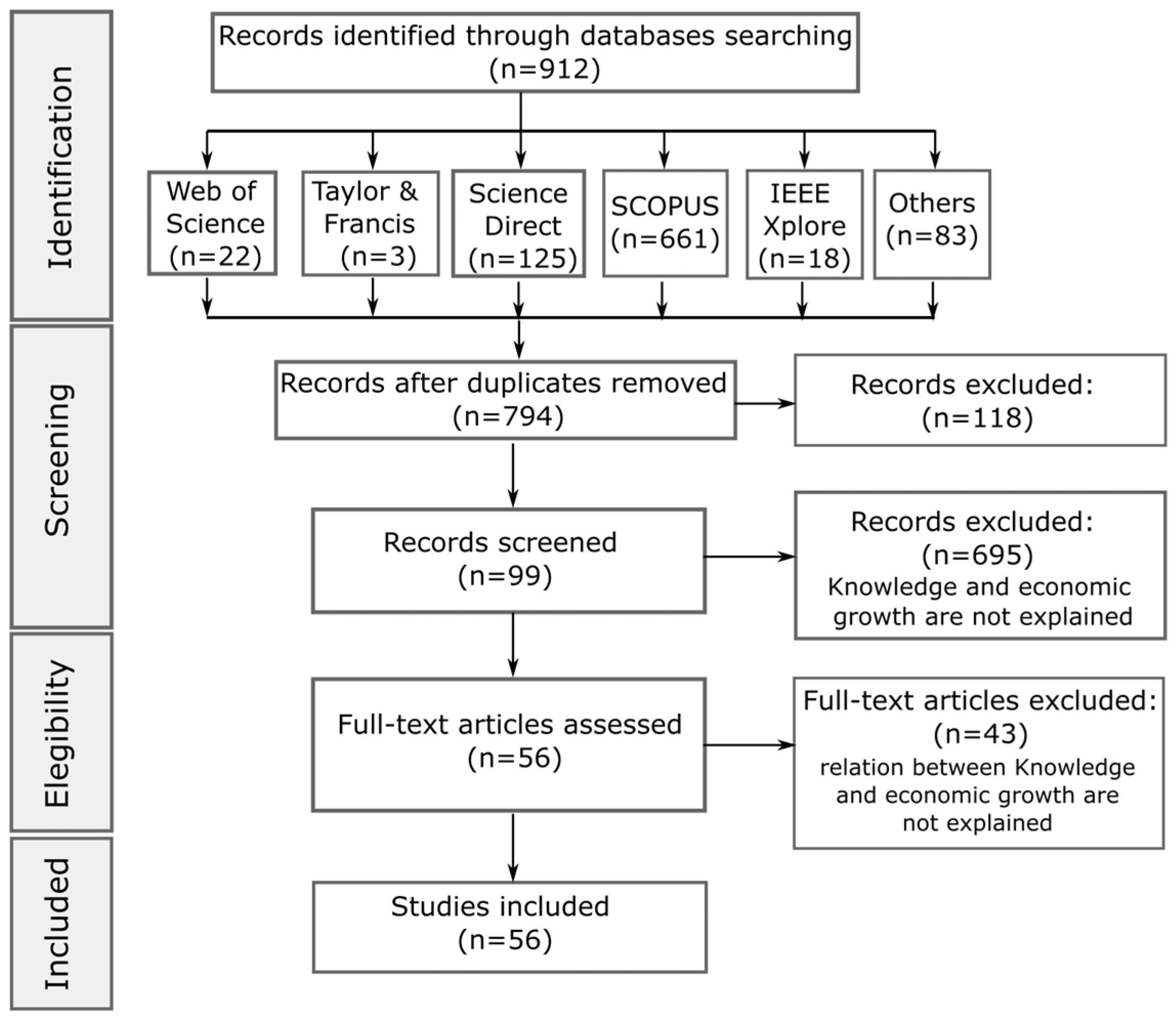
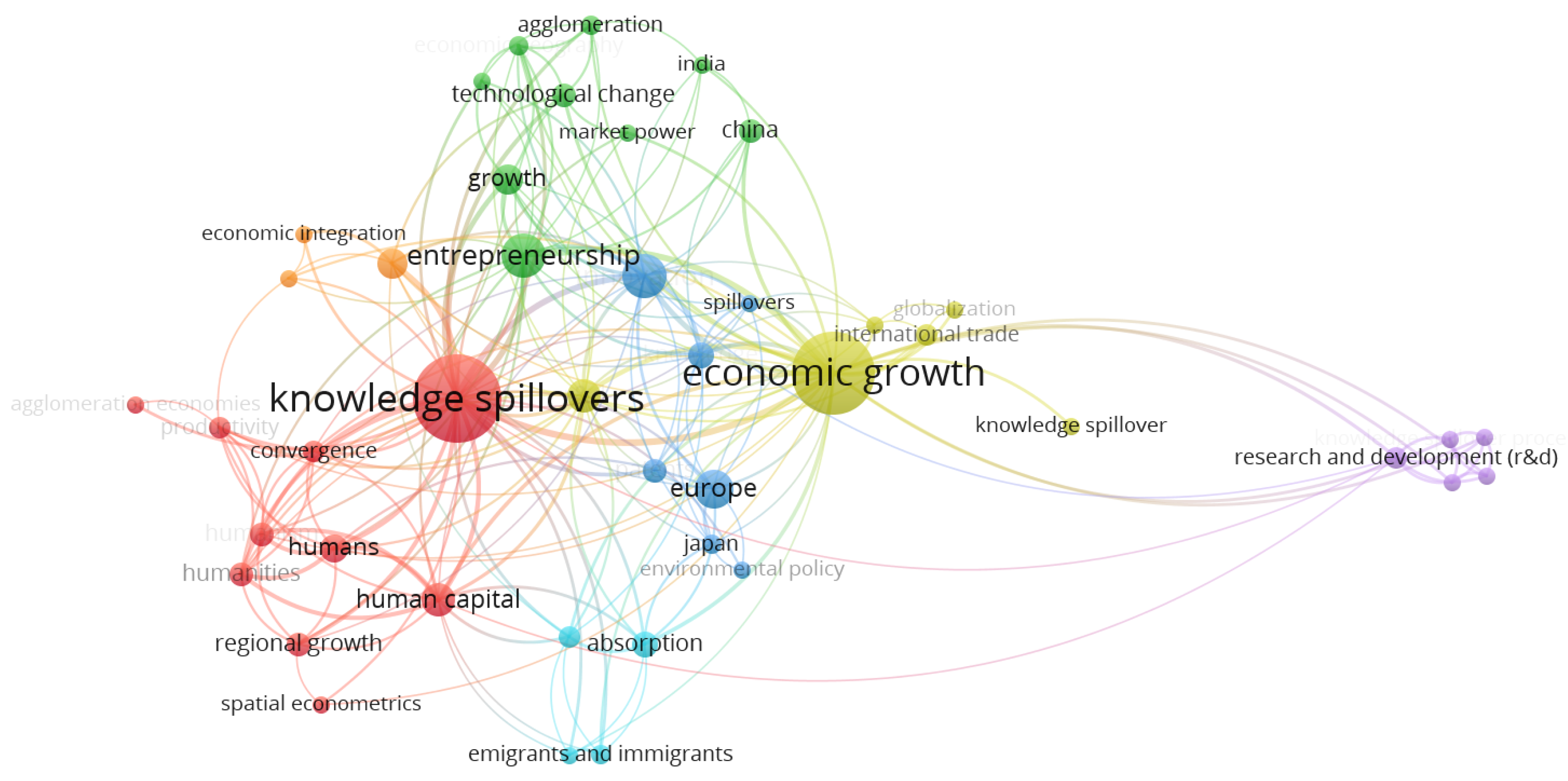
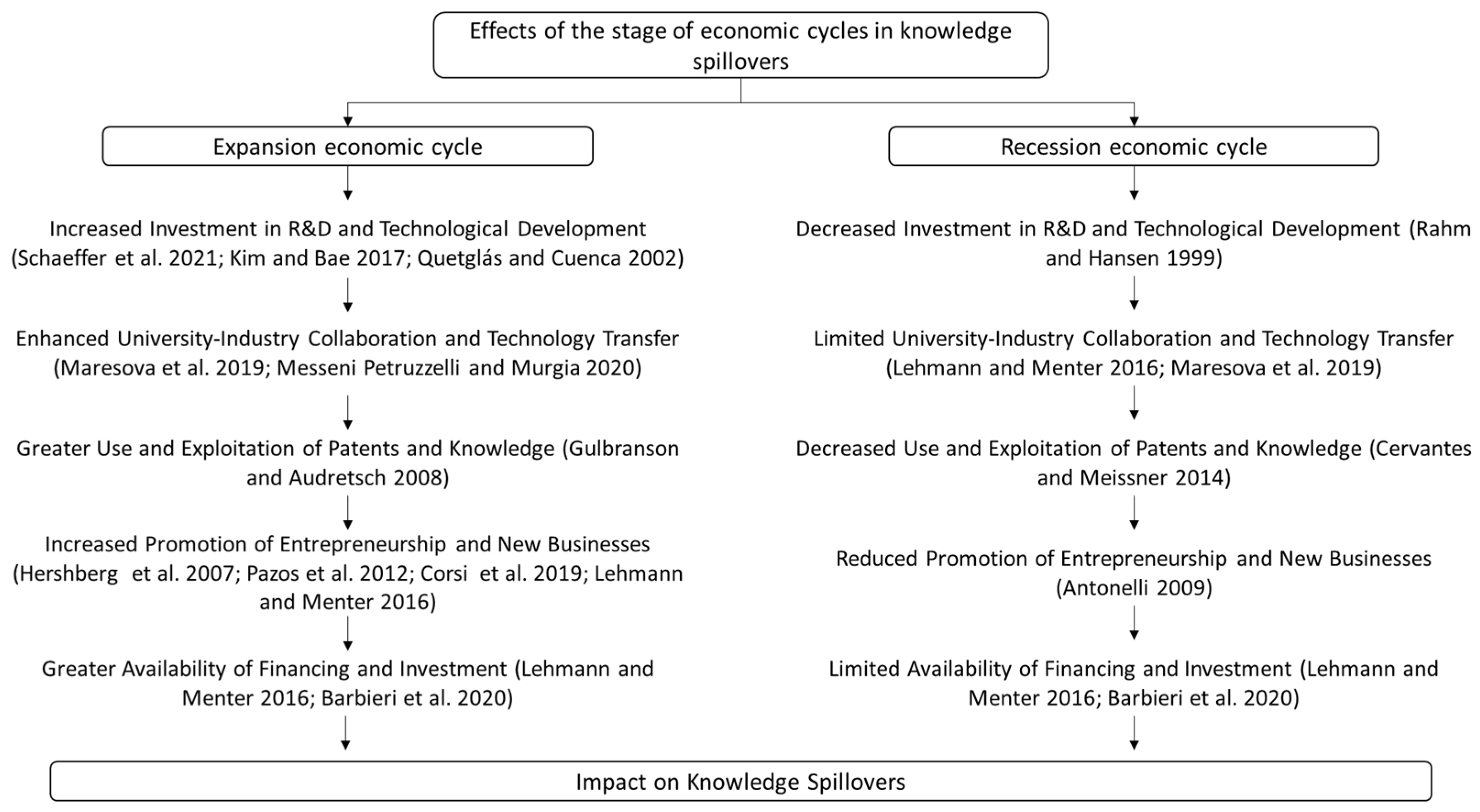
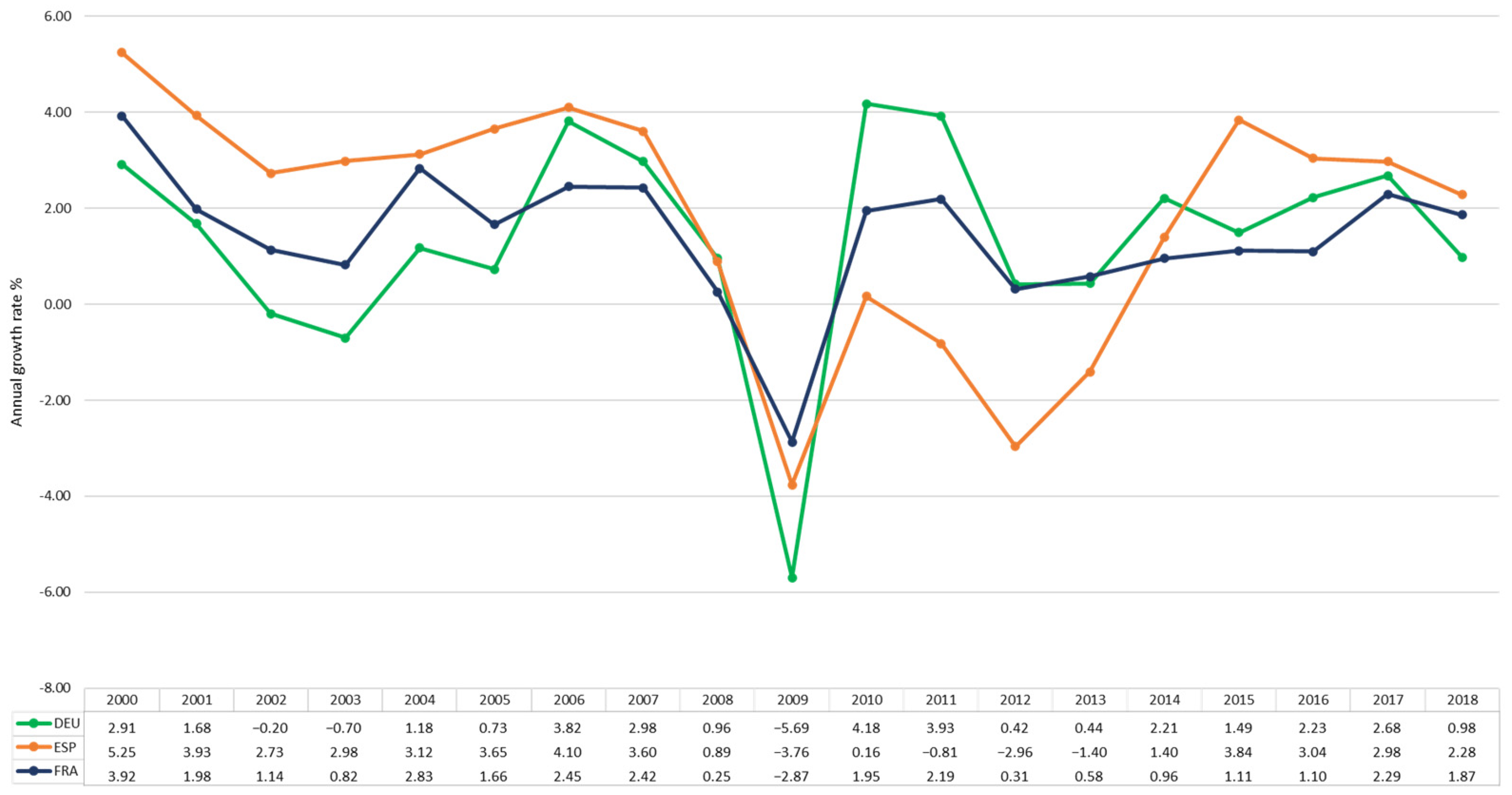
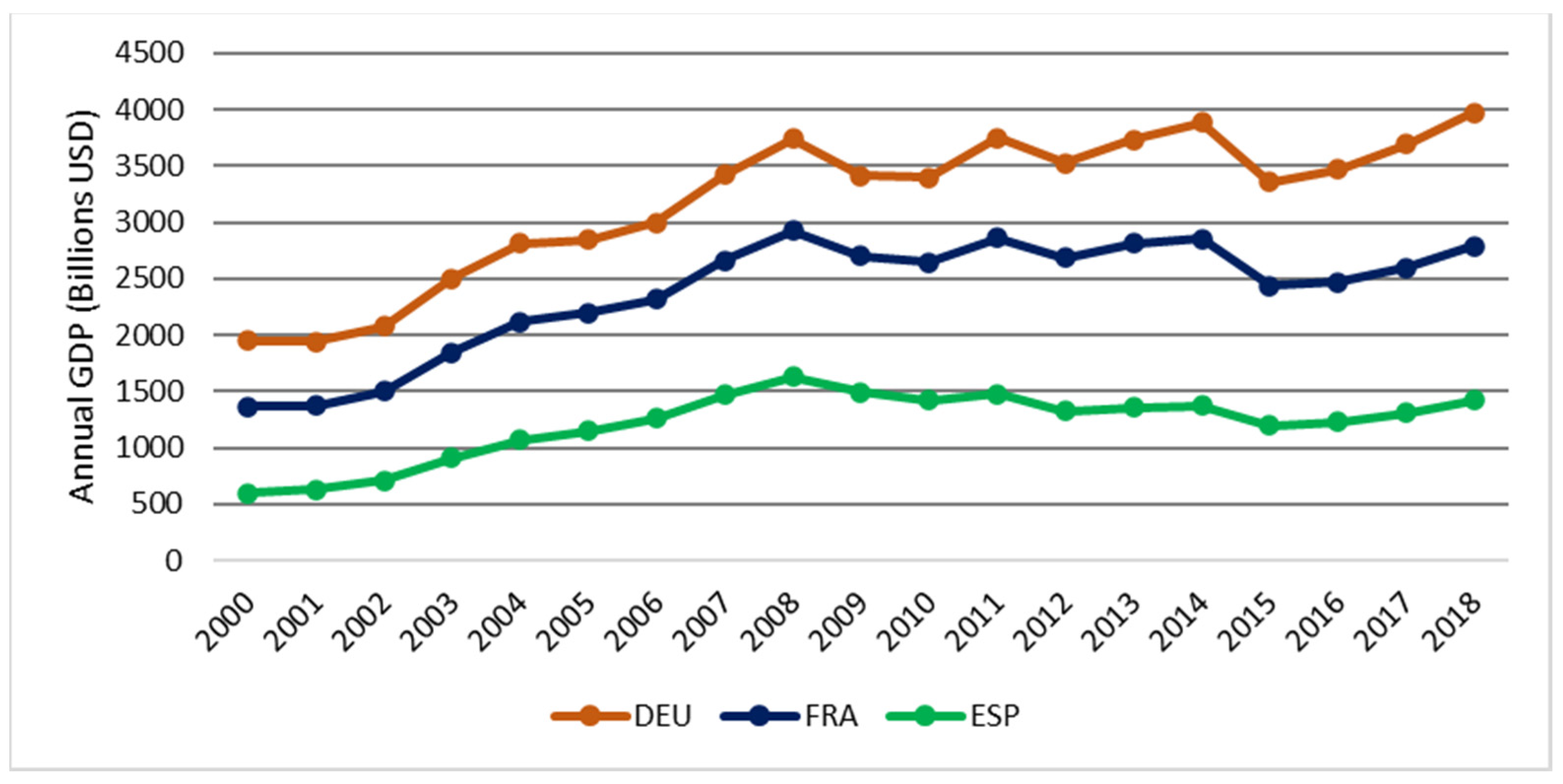
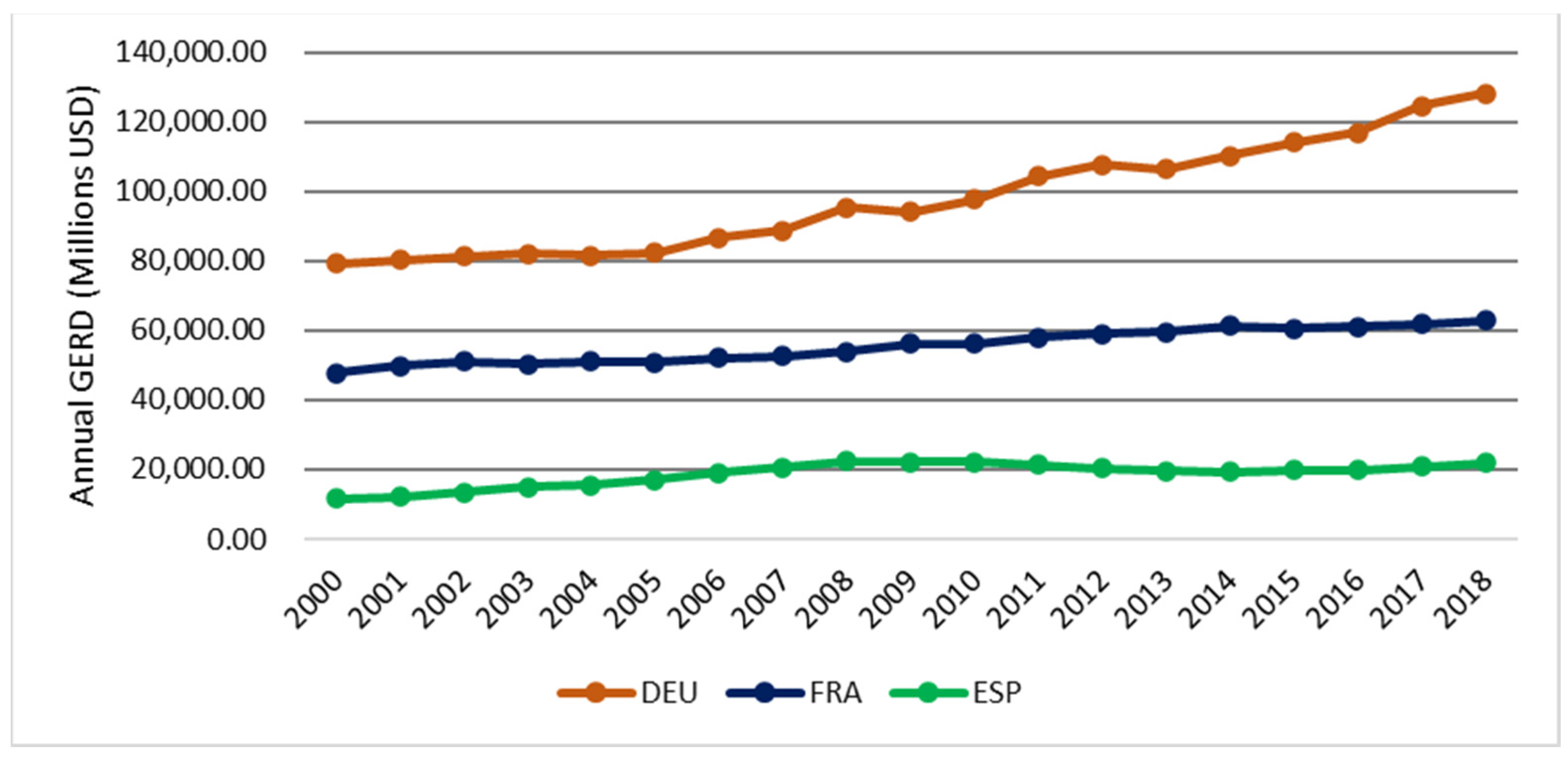
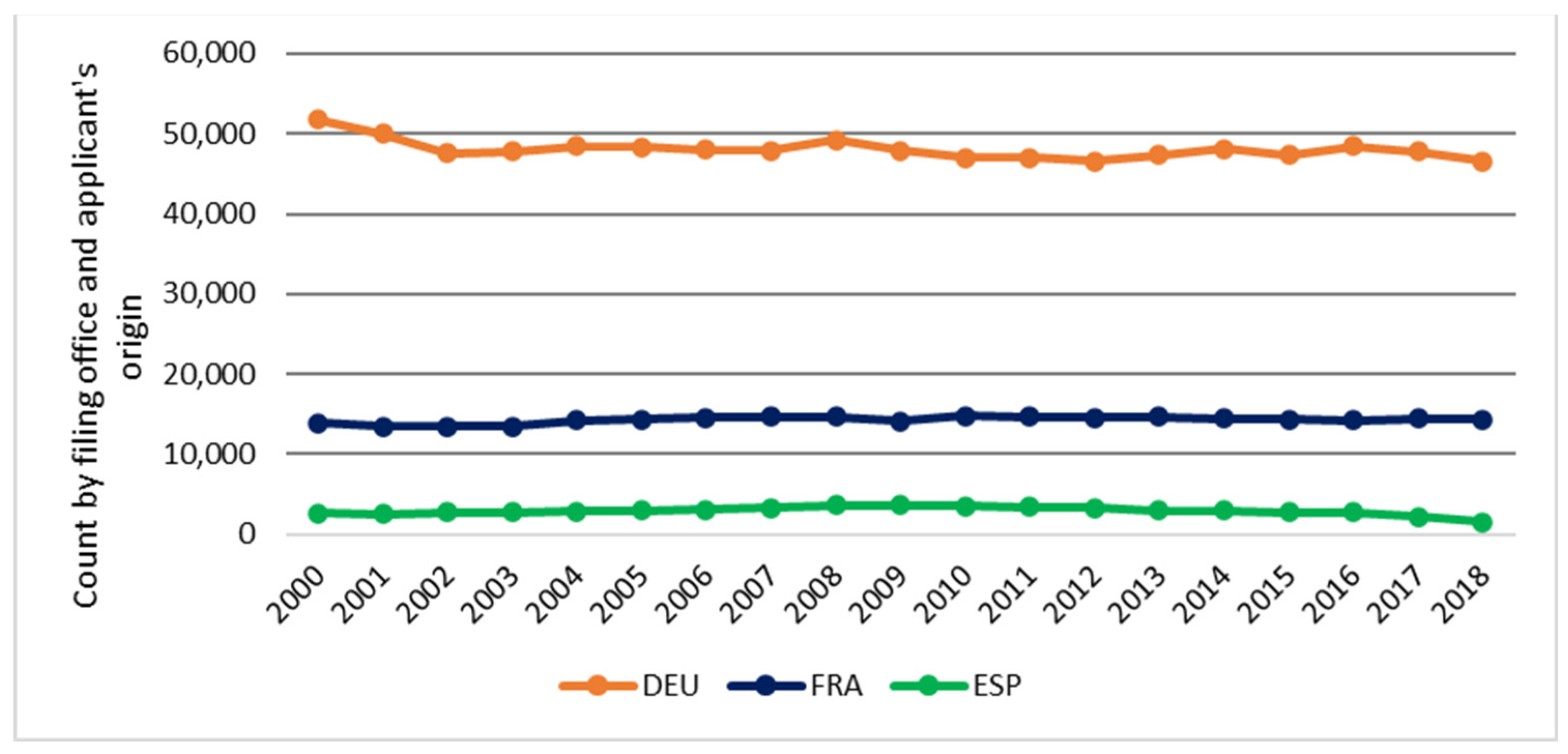
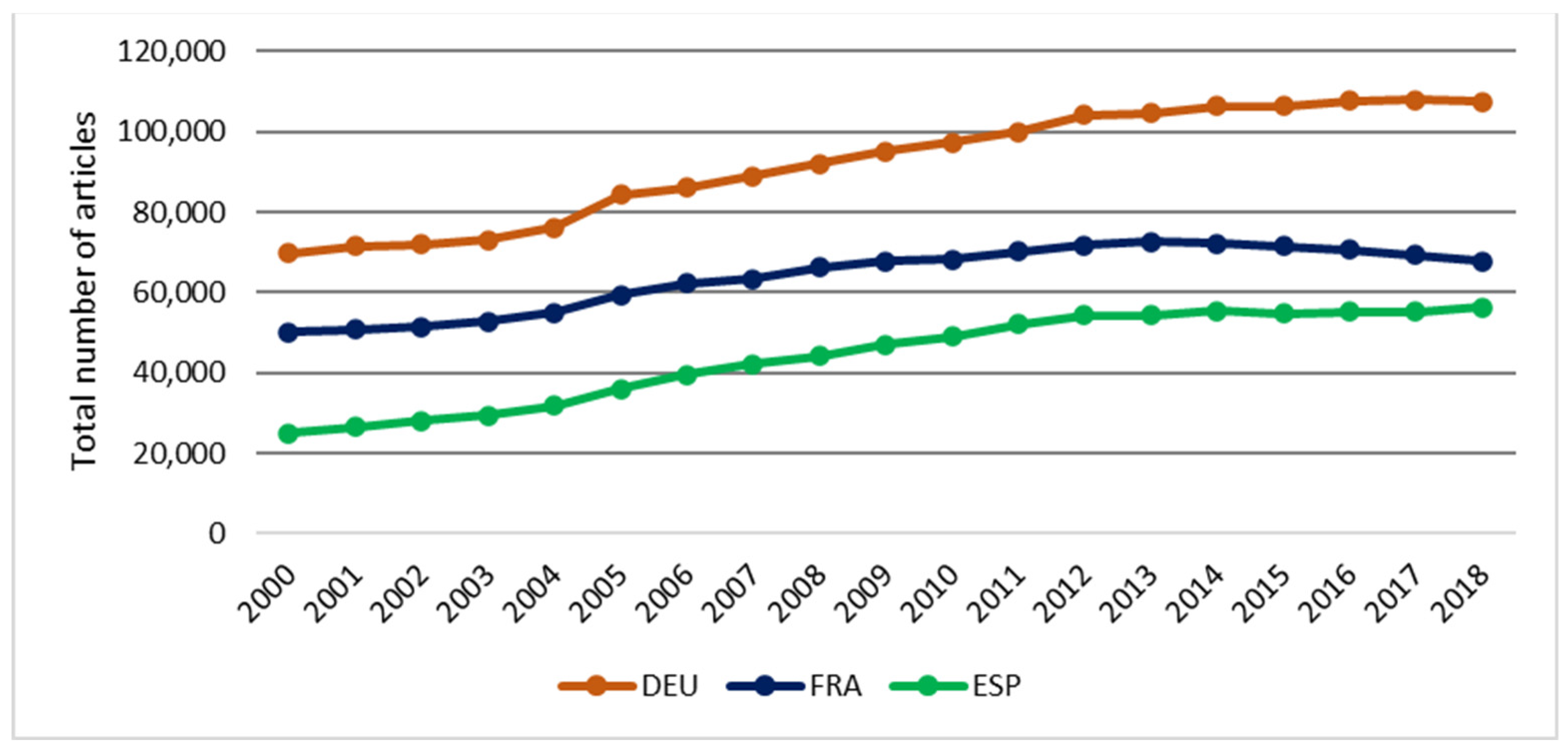

| Quality Assessment Questions Answer | Answer |
|---|---|
| Does the paper describe the positive and negative effects on the countries’ economies due to the influence of knowledge spillovers? | (+1) Yes/(+0) No |
| Does the paper describe how the economic cycle impacts knowledge spillovers? | (+1) Yes/(+0) No |
| Does the paper describe how knowledge spillovers affect economic growth? | (+1) Yes/(+0) No |
| Is the paper published in a journal or conference indexed in SJR? | (+1) if it is ranked Q1, (+0.75) if it is ranked Q2, (+0.50) if it is ranked Q3, (+0.25) if it is ranked Q4, (+0.0) if it is not ranked |
| Favorable Effects | Reference |
|---|---|
| Stimulate innovation and entrepreneurship to create new products, services, and processes that drive economic growth. | [10,21,66] |
| Enhance the productivity and efficiency of the economy by promoting the adoption of best practices and optimize organizational resources. | |
| Promote long-term competitiveness and economic development contributing to economic growth. | |
| Facilitate access to new ideas, information, and experience, thus promoting the development and implementation of new technologies. | [33] |
| Develop a skilled workforce as people acquire new knowledge and capabilities to improve productivity. | [62,75] |
| Foster collaboration between different economic actors, such as universities, research institutions, companies, and entrepreneurs to join efforts for growth and development. | [21] |
| Enable companies to increase competitiveness through efficient practices and develop innovative products. | [10,33] |
| Stimulate the transfer of technology and the commercialization of academic knowledge, generating income and promoting local economic growth. | [76] |
| Generate spin-off firms promoting innovation, employment, and economic growth. | [62] |
| Promote collaboration between natural sciences and business schools to enhance innovation and develop advanced technologies in the industry, thus benefiting economic growth. | [18] |
| Patent citation analysis helps to understand the transmission of information and innovation between different entities, e.g., countries, laboratories, companies, and universities. | [68] |
| Technology transfer and innovation have a positive impact on the economic cycles and growth of a country. | [26,27] |
| Promote creative organizational learning to enhance knowledge management processes and, in turn, improve organizational performance. | [23] |
| Hindering Effects | Reference |
|---|---|
| Economic inequality may increase due to unequal access to knowledge, resulting in disparities between technologically advanced companies and regions with limited access to information and knowledge. | [21] |
| Introducing advanced and more efficient technologies may initially result in job losses and economic instability in outdated fields. | |
| Inadequate protection of intellectual property rights may trigger the unauthorized appropriation of knowledge and technologies, discouraging investment in R&D. | [77] |
| The concentration of knowledge among a select few economic players may result in the creation of monopolies or dominant market positions market, limiting competition and innovation. | [78] |
| Due to rapid technological obsolescence, inefficient investment in technologies that soon become outdated will negatively affect companies’ profitability and sustainability. | [26] |
| The dissemination of incorrect or inadequate information may lead to incorrect decisions about the implementation of new technologies or practices, resulting in economic losses. | [79] |
| Lack of collaboration and partnership among economic actors may hinder knowledge flow and synergies driving innovation and economic growth. | [10] |
| Establishing solid links between individuals may be challenging when there are divergences in ideas and expectations, making knowledge transfer difficult. | [22] |
| Distinguish knowledge between investment in academic research and its transfer to the market. | [56] |
| Combining formal and informal knowledge spillover channels increases technology management’s complexity and slows its economic benefits. | [60] |
| Delays in patent examinations may impact the return on the investment. Factors such as the technical complexity of the invention and the number of claims filed may influence the span of the process and slow profiting from the patent. | [67] |
| Technology clusters may not benefit from assumed knowledge spillovers, and the complexities of these spillovers may not be immediately apparent. | [80] |
Disclaimer/Publisher’s Note: The statements, opinions and data contained in all publications are solely those of the individual author(s) and contributor(s) and not of MDPI and/or the editor(s). MDPI and/or the editor(s) disclaim responsibility for any injury to people or property resulting from any ideas, methods, instructions or products referred to in the content. |
© 2024 by the authors. Licensee MDPI, Basel, Switzerland. This article is an open access article distributed under the terms and conditions of the Creative Commons Attribution (CC BY) license (https://creativecommons.org/licenses/by/4.0/).
Share and Cite
Arcos-Guanga, A.; Flor-Unda, O.; Novillo-Villegas, S.; Acosta-Vargas, P. The Impact of Knowledge Spillovers on Economic Growth from a National Perspective: A Comprehensive Analysis. Sustainability 2024, 16, 6537. https://doi.org/10.3390/su16156537
Arcos-Guanga A, Flor-Unda O, Novillo-Villegas S, Acosta-Vargas P. The Impact of Knowledge Spillovers on Economic Growth from a National Perspective: A Comprehensive Analysis. Sustainability. 2024; 16(15):6537. https://doi.org/10.3390/su16156537
Chicago/Turabian StyleArcos-Guanga, Adriana, Omar Flor-Unda, Sylvia Novillo-Villegas, and Patricia Acosta-Vargas. 2024. "The Impact of Knowledge Spillovers on Economic Growth from a National Perspective: A Comprehensive Analysis" Sustainability 16, no. 15: 6537. https://doi.org/10.3390/su16156537
APA StyleArcos-Guanga, A., Flor-Unda, O., Novillo-Villegas, S., & Acosta-Vargas, P. (2024). The Impact of Knowledge Spillovers on Economic Growth from a National Perspective: A Comprehensive Analysis. Sustainability, 16(15), 6537. https://doi.org/10.3390/su16156537








